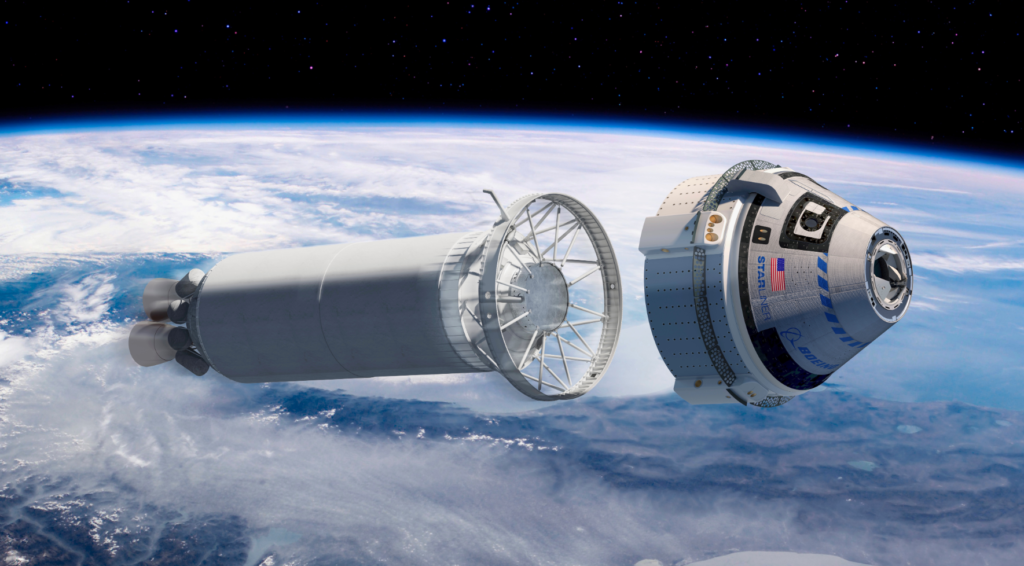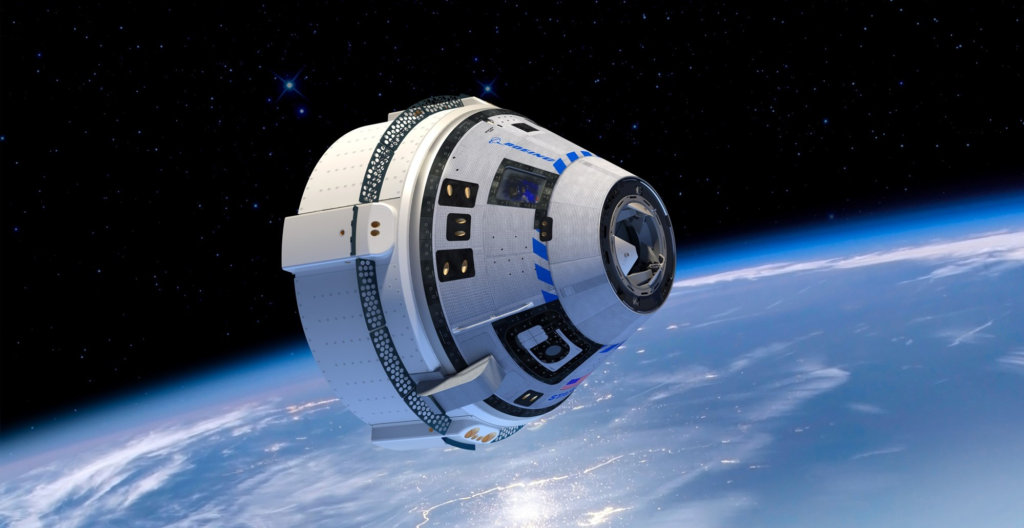
Starliner’s First Crewed Mission Has Been Indefinitely Delayed
The Boeing Starliner spacecraft has been trying to launch humans for years now. The original plan apart of NASA’s Commercial Crew Program was to have this spacecraft along with SpaceX’s Crew Dragon competing and both available to transport humans in LEO. Unfortunately, the Starliner has continued to run into different delays and complications with the recent reports following suit.
Just yesterday a Boeing official commented that they are “standing down” from an attempt to launch the Starliner spacecraft on July 21 to focus on recently discovered issues with the vehicle. These issues include two main problems surrounding the parachute system and flammable tape. While days ago these two specific areas were meant to go through a quick final check, they have turned into a significant delay.
So much so that no new launch date has been provided and the spacecraft may need to be disassembled to fix everything that’s wrong. Here I will go more in-depth into the two main problems, what this means for the future of Starliner, what to expect in the coming months, and more.
Delayed Indefinitely

Yesterday Boeing released an update that for the most part was vague and didn’t say too much about the issues at hand. In the statement, the company was quoted saying, “we have recommended to NASA that we reevaluate our launch window to allow for closing out the remaining technical and certification items.
We were notified by the parachute supplier of an issue, identified through testing, that reduced our safety margin. Our engineering team provided additional analysis and given that, we determined the safest course of action was to stand down for the July launch opportunity. We are now determining when we will be ready to launch, but anticipate additional parachute testing. We are committed to the Starliner program and are working closely with NASA to identify a new launch date” they said.
In reality, the company had known about these issues for a bit now. Mark Nappi, vice president, and program manager for Starliner, pointed out that the two spacecraft problems were discovered before Memorial Day weekend and that the company spent the holiday investigating them.
What’s most concerning is that these issues were only discovered weeks before the first crewed launch. Especially considering the fact that these two problems are very serious and affect the safety of the astronauts. Focusing on these two problems, first, Boeing engineers discovered that the “soft links” used on the suspension lines of Starliner’s three main parachutes have a failure load limit that is actually lower than previously thought. It turns out that those links, which secure the parachute lines with their anchor tethers on the capsule, cannot handle the load of Starliner if one chute fails. Being able to land safely with two of three chutes is a safety requirement for NASA, Nappi said.
As for the second problem, it has to do with the protective tape covering the wiring harnesses throughout the Starliner capsule. That tape, Nappi said, is flammable and there are “hundreds” of feet of it inside Starliner. This obviously creates a big problem as in most cases, anything that goes into space is made as flameproof as possible. During recent tests, it was discovered that under certain circumstances possible in flight, this tape is flammable. In regard to this specific problem, Nappi commented, “It’s highly unlikely that we would go in and cut this tape off,” doing so would likely cause more potential damage. “So we’re looking at solutions that would provide for essentially another type of wrapping over the existing tape in the most vulnerable areas that reduces the risk of fire hazard.”
Just days before Steve Stich, NASA’s Commercial Crew Program manager was quoted saying, “Crew safety remains the highest priority for NASA and its industry providers, and emerging issues are not uncommon in human spaceflight, especially during development. If you look back two months ago at the work we had ahead of us, it’s almost all complete. The combined team is resilient and resolute in their goal of flying crew on Starliner as soon as it is safe to do so. If a schedule adjustment needs to be made in the future, then we will certainly do that as we have done before. We will only fly when we are ready.”
Starliner Launch Date

With these problems now discovered and work starting to correct them, it brings up the question of when will this spacecraft truly be ready for a crewed flight. As of right now, it seems that no one has a good answer. The only answer we got from officials was Nappi who said it was “feasible” for the mission to fly in 2023, but he did not want to offer any dates. “I certainly wouldn’t want to commit to any dates or timeframes,” he said. This is not a good sign at all and practically rules out this year just based on the work and complications these issues have created.
It’s also important to point out that Boeing will now work to check every single inch of the spacecraft and make sure the flammable tape and parachute system are the only two issues. However, it’s possible through this process they discover even more problems that need to be addressed. One concerning comment that Nappi made was that while “Boeing was preparing to load propellant on Starliner ahead of the July flight, it found another sticky valve. Valves have been an ongoing problem with the Starliner spacecraft. These issues even go back to the initial test flights without crew.
For example, in July 2018, a test anomaly was reported in which there was a hypergolic propellant leak due to several faulty abort-system valves. During the August 2021 launch window, some issues were detected with 13 propulsion-system valves in the spacecraft prior to launch. Attempts to fix the problem at the VIF also failed, and Boeing decided to return the spacecraft to the factory, thus canceling the launch at that launch window. The valves had been corroded by the intrusion of moisture, which interacted with the propellant, but the source of the moisture was not apparent.
At the same time as all of this has been happening, two NASA astronauts — Sunita Williams and Butch Wilmore — have been waiting and training to fly Starliner’s first crewed flight. At the start of the year, that test flight was targeted for February, but it has steadily slipped later and later in the months since. In 2021, two other NASA astronauts originally assigned to fly on Starliner, Nicole Mann and Josh Cassada, were reassigned to fly on SpaceX’s Dragon so they could complete their missions. Both have since done so. Steve Stich said that the entire team feels the pain of yet another delay. “I would say everybody is a bit disappointed,” Stitch told reporters Thursday, adding that Boeing and NASA engineers discussed the delay together in a meeting this week. “But you could see people ready to go roll up their sleeves and go see what the next steps are” he said.
In the grand scheme of things, these delays and new problems bring up ever bigger concerns for the Starliner program. Just last week, NASA’s Aerospace Safety Advisory Panel urged NASA to bring in independent experts to assess the viability of Starliner. “Given the number of remaining challenges to certification of Starliner, we strongly encourage NASA to step back and take a measured look at the remaining body of work with respect to flying CFT,” Patricia Sanders, chair of the committee, said on May 25.
The biggest concern however has to do with the program as a whole and how the continued problems affect it. Boeing originally received a $4.2 billion award from NASA in 2014. Due to continued delays and issues with the spacecraft, the company has already been charged around $900 million against its award. The most recent delay announced yesterday is likely to add to this total and bring it above 1 billion. The drastic decision would be Boeing pulling out of the commercial crew program or the Starliner program.
Currently, this doesn’t seem to be the plan at all. Boeing is on the hook for at least seven crewed flights for NASA, including the Crew Flight Test and six operational astronaut missions, as part of its NASA contract. Despite the repeated delays, Nappi said Boeing remains committed to its Starliner spacecraft and fulfilling its NASA obligations. “We’ve been talking about the future of Starliner and how we’re going to move forward,” Nappi said. “We know that there’s growing pains in developing vehicles and flying vehicles … This is just part of the business to have these kinds of issues.”
NASA wants to have two different spacecraft available for astronaut flights so it is not dependent on a single company to fly astronauts in space, Stich added. “NASA desperately needs a second provider for transportation,” he said. “Our ultimate goal is to have one SpaceX and one Boeing flight per year rotate up to the station.” Something much easier said than done as teams work to take apart and fix the Starliner spacecraft.
Conclusion
Boeing can’t catch a break with Starliner as only weeks before its first crewed test flight two significant issues are discovered. Now the company and agency aren’t sure when the test flight will happen with officials not confident in a 2023 launch. We will have to wait and see how it progresses and the impact it has on the space industry.
